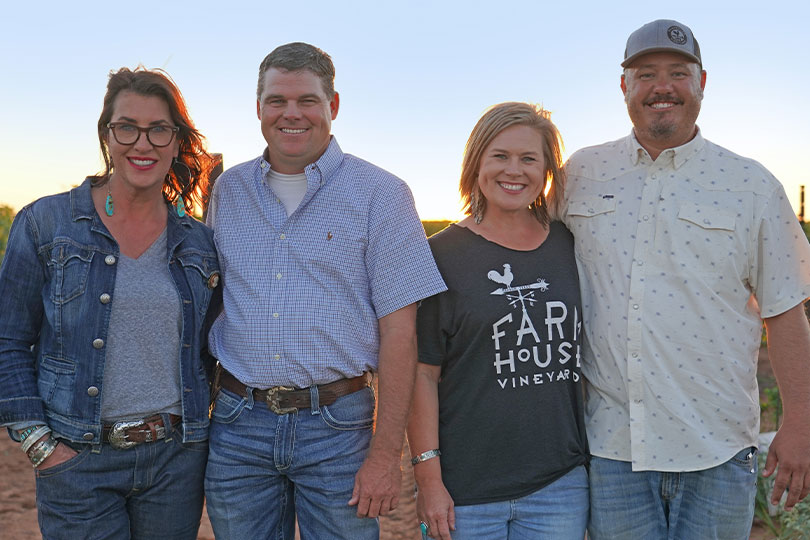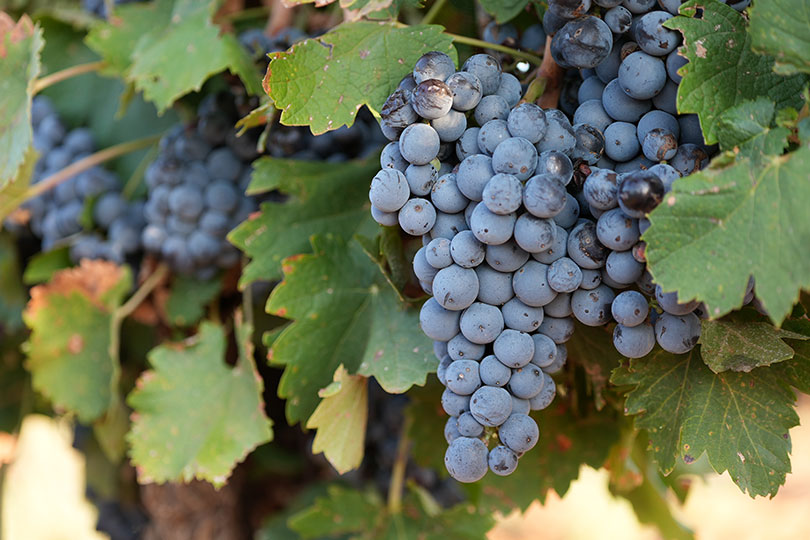By Shelby Shank
Field Editor
Farmhouse Vineyards in Brownfield is a family affair. It’s owned and operated by siblings Nicholas Seaton and Traci Furgeson, along with their spouses Katy Jane and Anthony.
Together, the families bring unique personalities and a shared passion that blends well on the farm they started in 2010.
The farm began with 1,200 acres but has since expanded to 7,000 acres with diverse crops and livestock. They raise 3,000 head of Dorper sheep and grow cotton, peanuts, black-eyed peas, melons, pumpkins and various grains.
They also devote 175 acres to grow their premium Texas wine grapes.
“It’s fascinating to look back to see where we started and where we are now,” Anthony said.
Why wine?
Their decision to grow grapes was driven by the desire to conserve their most valuable resource—water.
“We want to utilize the most water that we possibly can,” Anthony said. “That’s why we integrated the grapes because they use less water, and you’re able to put that water exactly where it needs to go.”
The farm’s irrigation system allows them to rotate water efficiently between the grapes and other crops.
Farmhouse Vineyards is known for their Malvasia Bianca and Counoise grapes. They were the first to plant Counoise in Texas, leading the families to become one of the largest commercial producers of wine grapes in Texas.
“These grapes are dear to our hearts because we couldn’t give them away at the beginning,” Traci said. “There wasn’t a winery that would take it. We tried giving them away, and now we have a list of wineries on a waiting list wanting our grapes.”
The families grow over 20 varieties and supply grapes for the top 20 wineries in Texas. Their grapes primarily go to wineries in the Hill Country and Austin, and a small portion of their grapes are bottled under their own Farmhouse Vineyards label.

Growing grapes on the High Plains
The sandy soil of the Texas High Plains is optimal for growing wine grapes, but the region’s risk for drought and frost can be a challenge.
“From the time you plant that grape, you hope to get 15 to 30 or more years of life in that vineyard,” Anthony said.
The growing process is year-round. Pruning begins in February, followed by budding in March or April. The fruit sets in May, and veraison, which is where the grapes turn colors, happens in July. This process signals that the grapes are maturing and nearing harvest.
White grapes are harvested in mid-August, and red grapes are picked between late August through early October.
Harvesting requires precision. There is a three- to four-day window when the grapes reach peak ripeness, determined through a mix of scientific measurements and taste.
The grapes are harvested at night to keep them cool and prevent premature fermentation.
“The coolness delays the fermentation,” Anthony said. “Being six hours away from most of our winemakers, you want to pick the grapes as cool as you can. That’s why harvesting happens at night because that’s when it’s the coolest in the day.”
A mechanical harvester gently shakes the vines to dislodge the grapes. The machine is equipped with sorting mechanisms to separate the grapes from leaves, stems and other debris.
“We want to be as delicate with that vine as possible but still be able to get the berries off,” Nicholas said. “We want to pass through there as quickly as possible but leave the unripe fruit on and get the ripe fruit off.”
Once picked, the grapes are transported in refrigerated trucks to wineries across Texas.
Farmhouse Vineyards grows between 500 to 800 tons of fruit, producing almost 500,000 bottles of wine annually.

A taste of family tradition
For the Ferguson and Seaton families, farming is a business, but it’s also about continuing a legacy.
Siblings Nicholas and Traci grew up on their family farm in Terry County, and Anthony grew up on a cotton farm in Bailey County.
“I knew from a very young age that I wanted to farm,” Nicholas said. “I was blessed with a family that laid a great foundation of hard work, and I knew I wanted to do the same.”
Anthony had a career in finance before coming back to agriculture.
“Growing up farming, you can’t really wash it off,” Anthony said. “I worked in finance for a little while but always felt that that’s not where I needed to be. I needed to be out in the dirt and being hands-on with the land.”
Their agricultural roots and passion continue to bear fruit on the farm and in the vineyard. They hope to pass down their love for agriculture to their children and instill the same values of hard work and care for the land.
Farmhouse Vineyards also welcomes the public to learn about viticulture. Their tasting rooms in Brownfield and Johnson City are set inside renovated houses, designed for customers to feel like they’re at home.
“We intentionally put our tasting rooms in houses because we want people to feel like they’re just coming over for a glass of wine and fellowship,” Katy Jane said.
The space creates an opportunity for the families to share about the journey of wine from grape to glass.
“It’s been great to have a house to open up and feel like we are sharing a part of our home and our life with visitors,” Traci said. “That’s been my favorite part about pouring wine for people—the opportunity to teach people about agriculture and where their food and fiber comes from.”
By blending tradition with innovation, the Furgesons and Seatons are honoring their agricultural heritage while carving out a new path in the Texas wine industry.


Leave A Comment